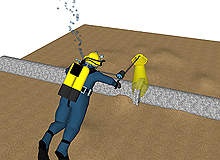
In La Spezia, Italy, Co.L.Mar has been working with marine acoustic engineering since 1982. In 1998, the company built the Acoustic Leak Detection system, which has been evolving ever since.
“We have confirmed that acoustic is the most reliable technology for detecting leaks underwater,” said Co.L.Mar’s managing director, Luigi Barbagelata.
“Other techniques are based on the chemical or optical detection of substances dispersed in the leaking fluid. All these techniques are affected by current, turbidity and pipeline burial.”
He did say however, that non-acoustic sensors can be useful in some particular circumstances. “For this reason, in the last version of the ALDO sensor we have added a free channel to host a secondary sensory (dye detector or hydrocarbon detector),” he said.
The subsea environment is challenging, especially when pipes are being laid. “We have often been called to detect leaks in such situations. As an example, our first job was in the Yellow Sea with a six knot current, zero visibility and 2.5m pipeline burial,” said Barbagelata, who confirmed the company detected two existing leaks in the pipeline.
“To date we have a 100 per cent success rate and this is due, I believe, to our flexibility and experience,” said Barbagelata, who elaborated that Co.L.Mar designed and built all of the main components for the ALDO system.
“These capabilities together with the experience allows us, when necessary, to adapt the inspection system and the procedures to each application. We can offer a range of field proven inspection techniques: ROV (remotely operated vehicle), towed, diver, etc.”
Software to plug a gap
Since the 1990s, software has made leaps and bounds. “Our ALD proprietary software is one the most important components of the system, which is covered by an international patent,” said Barbagelata, who confirmed the data was analysed using four different techniques before displaying the results in real-time. This is the key of the system, sensitivity, which allows us to detect, operating from an ROV, leaks smaller then 0.5 lt/min (litre per minute) in monitoring applications where ambient noise is lower, detection limits are much smaller,” said Barbagelata.
Going forward, Barbagelata said Co.L.Mar started a project about a year ago for a fixed installation leak monitoring system. “The system should be ready by early next year (2012).”
He went on to say that Co.L.Mar expected the forthcoming new subsea leak prevention regulations will “request the installation of leak monitoring systems to prevent ambient pollution. We want to be ready to take part in this challenge.”
Fibre optic pipeline monitoring
In Morges, Switzerland, Omnisens SA specialises in fibre optic monitoring, including subsea pipeline monitoring. The company can deploy fibre optic umbilical sensors for deepwater applications.
“The fibre optic sensing solutions we have developed are designed to operate down 3000m, which is a typical pre sal depth,” said Omnisens’ Latin America area manager, Fabien Ravet. “So far, the limit is determined by the application and not the fibre optic sensing technology,” he said.
Ravet also said the greatest challenge “is the integration of the fibre optic sensor to the structure (umbilical, riser, pipeline) that needs to be monitored, which can only be overcome by working closely with the structure manufacturer. Integrating the sensing element upstream in the manufacturing process is key.”
He said that, through the fibre, leak detection is based on temperature for small leaks and acoustic detection for larger leaks. Software analyses the temperature / acoustic signature and the system has the ability to identify and discriminate the leak from another event.
“We certainly have moved from very basic data processing towards event signature identification,” said Ravet, who went on to say that acoustic fingerprinting of the event “reduces both the latency time and the false alarm rate.”
Coexisting systems
When asked if fibre optic sensing would be a replacement for traditional acoustic systems, he said, “As a general comment, we can state that fibre optic is meant to be used in new installations, while acoustic is a little bit easier to install in existing installations. They would then probably coexist for some time.”
Ravet pointed out the advantages of fibre optic sensors which “can detect strain, temperature and acoustic events which is more comprehensive than just pure / traditional acoustic detection applying to leaks only.
“As a consequence, with fibre optics we can take preventive actions as we detect the events that would lead to a leak such as impacts or fatigue. Moreover, fibre optic systems cover longer distances, detect faster and have better sensitivity.”
Ravet said Omnisens has been working for Statoil in the North Sea and are actively involved with “various umbilical manufacturers to develop deep-sea umbilical monitoring systems. These umbilicals are intended to be installed in the Gulf of Mexico, in Northern Australia and in Brazil.”
Pipe-pulse
Working out of Aberdeen in the UK, Paradigm Flow Solutions Ltd launched its patented Pipe-Pulse technology at the Offshore Technology Conference in Houston recently.
Paradigm says it can locate and remove blockages in pipelines for up to 30 miles. They have already won a $250,000 contract to unblock a pipeline in the North Sea and say their system takes pipeline treatment ‘topside’ for the very first time.
The company said the system works via a series of control valves within the main body of the Pipe-Pulse unit.
Using proprietary algorithms that determine the optimum wave structure for each job, the unit creates and injects the manufactured pulse into the pipeline and thus to the front face of the blockage.
During test phases it was able to clear a multi-phase flow line for Shell UK that had been blocked for 11 years, and also removed a stuck pig in a deepwater flow line for Petrobras Americas.



